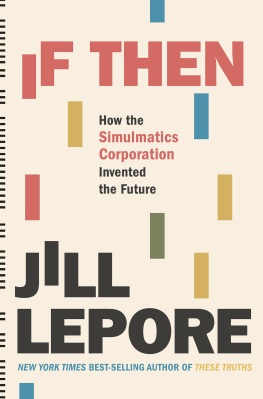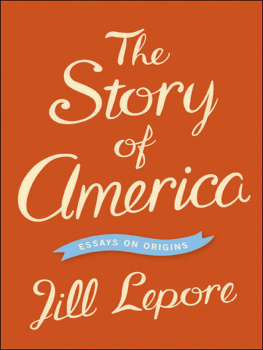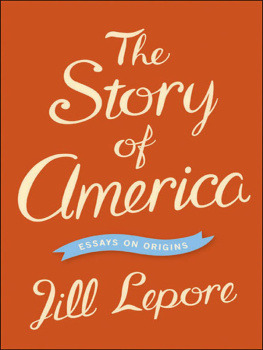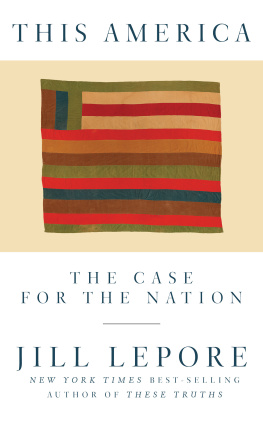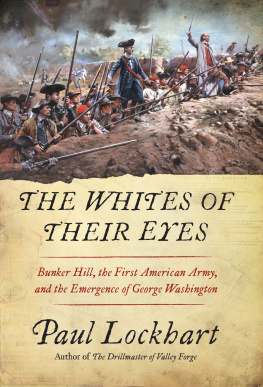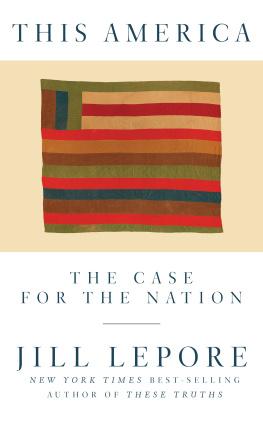THE WHITES
OF THEIR EYES

The Public Square Book Series
PRINCETON UNIVERSITY PRESS
Ruth OBrien, Series Editor
THE WHITES
OF THEIR EYES
The Tea Partys
Revolution and the
Battle over
American History
JILL LEPORE

Copyright 2010 by Jill Lepore
Requests for permission to reproduce material from this work
should be sent to Permissions, Princeton University Press
Published by Princeton University Press,
41 William Street, Princeton, New Jersey 08540
In the United Kingdom: Princeton University Press,
6 Oxford Street, Woodstock, Oxfordshire OX20 1TW
press.princeton.edu
All Rights Reserved
Library of Congress Cataloging-in-Publication Data
Lepore, Jill, 1966
The whites of their eyes : the Tea Partys revolution and the battle over American history / Jill Lepore.
p. cm. (The public square book series)
Includes bibliographical references and index.
ISBN 978-0-691-15027-7 (hardcover : acid-free paper) 1. United StatesHistoryPhilosophy. 2. United StatesHistoriographySocial aspects. 3. United StatesHistoriographyPolitical aspects. 4. United StatesHistoryRevolution, 17751783Influence. 5. United StatesHistoryErrors, inventions, etc. 6. Tea Party movement. 7. FundamentalismUnited States. 8. EvangelicalismUnited States. 9. Right-wing extremistsUnited States. I. Title.
E175.9.L46 2010
973.3'115dc22
2010030251
British Library Cataloging-in-Publication Data is available
Parts of this book were originally published in The New Yorker.
The spelling, capitalization, and punctuation of eighteenth-century writing have been left, whenever possible, as they were in the original.
This book has been composed in Sabon
Printed on acid-free paper.
Printed in the United States of America
10 9 8 7 6 5 4 3 2 1
To my sons
I do not mean to say, that the scenes of the revolution
are now or ever will be entirely forgotten;
But that, like everything else, they must fade
upon the memory of the world, and grow
more and more dim by the lapse of time.
Abraham Lincoln, 1838
CONTENTS
FOREWORD
Ruth OBrien
Recalling the soldiers at Bunker Hill who, facing the British, were told to get close enough to see the whites of their eyes, Jill Lepores magnificent book takes a very close look at both the founding of the United States and its legacythe unending battle over American history. In artful and vivid prose, Lepore takes readers the distance between past and present, and then back again, sometimes all in the space of a page, to explain, for instance, how the Revolution could spawn both the conservative Tea Party, in the twenty-first century, and its ideological oppositethe liberal Tax Equity for Americans (TEA) Party, in the 1970s and, finally, to offer a thoughtful meditation on history itself. The study of history, she argues, is always controversial, contentious, and contested, but the Tea Partys Revolution was antihistorical, tangling together originalism, evangelicalism, and fundamentalism. Lepore, deftly navigating between history, culture, and politics, also offers a caution about her own profession. In the 1970s, she argues, academic historians belittled the Bicentennial as schlock but didnt offer an answer, a story, to a country that needed one. That left plenty of room, she suggests, for a lot of other people to get into the history business. And they did.
Beginning in 2009, one month after the election of Barack Obama, the Tea Party charged the new administration with imposing taxation without representation, as if health care legislation, passed by Congress in 2010, were like the Stamp Act, imposed by Parliament in 1765. Lepore shows us, though, that this kind of maneuver was not new. Americans have drawn Revolutionary analogies before, she writes. They have drawn them for a very long time. To reveal how historians think about the past, Lepore carries readers on a journey, her journey, as she scrambles onto a replica Revolutionary ship, sits in dimly lit Revolutionary taverns, and attends Revolutionary reenactments. By musing on how the past can better inform the present and on how historians might play a civic role, this book enters the public arenaand the Public Square.
THE WHITES
OF THEIR EYES
PROLOGUE
Party Like Its 1773
One morning last March,
I pressed against the new barbed and galvanized
fence on the Boston Common.
Robert Lowell, For the Union Dead, 1960
Americans love an anniversary.
On the day I went to Gloucester, the Beaver was a skeleton, a ghost ship, but the Tea Party was the talk of the nation.
Within hours, Santellis call to arms was dubbed the rant heard round the world, a reference to a poem written by Ralph Waldo Emerson in 1836
Here once the embattled farmers stood
And fired the shot heard round the world
Michael Johns of the Heritage Foundation, believing that the United States was founded as a Christian nation, wanted to send this message to the White House:
Mr. Obama, every historical document signed in Philadelphia, every founding document in this nation, has cited our creator. That is the basis on which we distinguish ourselves in the world. And it is the foundation of our liberty and our God-given freedom.
David Tuerck, an economist from Suffolk University, wore a George Washington tie: In case there are any people here with Obamas picture in their living room, they can see what a real patriot looks like. The problem wasnt just in DC, Tuerck said. Right here in Massachusetts, we have a Supreme Judicial Court that thinks it can redefine marriage without a thought to the will of the people. (In 2004, same-sex marriage became legal in Massachusetts when the states highest court ruled that its restriction was unconstitutional.) Its time for us to rally around a new cause, Tuerck said, which is to return America to the principles for which our forefathers fought and died. Its time for a new American Revolution. And I can think of no better place to start that revolution than right here.
we need to reeducate ourselves, because the present education system wont.
At the time, I happened to be teaching an undergraduate seminar on the American Revolution at Harvard, reading monographs and articles in scholarly journals; visiting archives; transcribing letters and diaries; touring graveyards and museums; and grading papers on the Stamp Act, the Boston Massacre, the Intolerable Acts, the Battle of Lexington and Concord, the Siege of Boston, and the Battle of Bunker Hill. Meanwhile, at home, my nine-year-old was busy memorizing Henry Wadsworth Longfellows 1860 poem, Paul Reveres Ride, an assignment given, every year, by a masterful teacher in a public school in Cambridge, arguably the most liberal city in the most liberal state in the nation. In my house, we couldnt sit down for dinner without one or another of the under-tens clearing his throat and reciting
Listen, my children, and you shall hear
Of the midnight ride of Paul Revere,
On the eighteenth of April, in Seventy-five;
Hardly a man is now alive
ic: a liberty tree.
In the spirit of our Founding Fathers, with our liberties once again threatened, we introduce our own Liberty Tree. Now as you can see, our tree is built upon the roots of life, liberty, pursuit of happiness, and freedom. They support the trunk of the tree, which is made of we the people. And the trunk supports the branches and the fruits of our liberty represented by the apples. It is those apples, the fruits of our liberty, that this administration is now picking clean.
Next page

